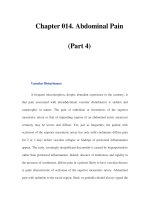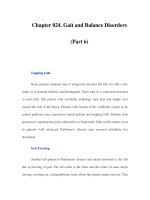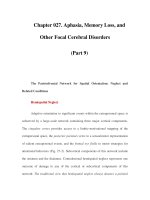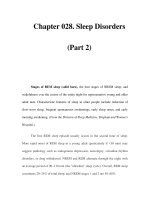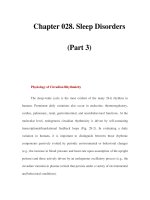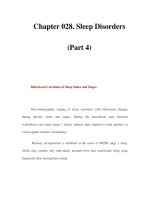Chapter 110. Coagulation Disorders (Part 9) ppsx
Bạn đang xem bản rút gọn của tài liệu. Xem và tải ngay bản đầy đủ của tài liệu tại đây (46.79 KB, 5 trang )
Chapter 110. Coagulation Disorders
(Part 9)
Differential Diagnosis
The differential diagnosis between DIC and severe liver disease is
challenging and requires serial measurements of the laboratory parameters of DIC.
Patients with severe liver disease are at risk for bleeding and manifest laboratory
features including thrombocytopenia (due to platelet sequestration, portal
hypertension, or hypersplenism), decreased synthesis of coagulation factors and
natural anticoagulants, and elevated levels of FDP due to reduced hepatic
clearance. However, in contrast to DIC, these laboratory parameters in liver
disease do not change rapidly. Other important differential findings include the
presence of portal hypertension or other clinical or laboratory evidence of
underlying liver disease.
Microangiopathic disorders such as thrombotic thrombocytopenic purpura
present an acute clinical onset of illness accompanied by thrombocytopenia, red
cell fragmentation, and multiorgan failure. There is, however, no consumption of
clotting factors or hyperfibrinolysis.
Disseminated Intravascular Coagulation: Treatment
The morbidity and mortality associated with DIC are primarily related to
the underlying disease rather than the complications of the DIC. The control or
elimination of the underlying cause should therefore be the primary concern.
Patients with severe DIC require control of hemodynamic parameters, respiratory
support, and sometimes invasive surgical procedures. Attempts to treat DIC
without accompanying treatment of the causative disease are likely to fail.
Management of Hemorrhagic Symptoms
The control of bleeding in DIC patients with marked thrombocytopenia
(platelet counts <10,000–20,000/mm
3
) and low levels of coagulation factors will
require replacement therapy. The PT (>1.5 x normal) provides a good indicator of
the severity of the clotting factor consumption. Replacement with FFP is indicated
(1 unit of FFP increases most coagulation factors by 3% in an adult without DIC).
Low levels of fibrinogen (<100 mg/dL) or brisk hyperfibrinolysis will require
infusion of cryoprecipitate (plasma fraction enriched for fibrinogen, FVIII, and
vWF). The replacement of 10 U of cryoprecipitate for every 2–3 U of FFP is
sufficient to correct the hemostasis. The transfusion scheme must be adjusted
according to the patient's clinical and laboratory evolution. Platelet concentrates at
a dose of 1–2 U/10 kg body weight are sufficient for most DIC patients with
severe thrombocytopenia.
Clotting factor concentrates are not recommended for control of bleeding in
DIC because of the limited efficacy afforded by replacement of single factors
(factor VIII or IX concentrates) and the high risk of products containing traces of
activated blood proteases (PCCs), which further aggravates the disease.
Replacement of Coagulation or Fibrinolysis Inhibitors
Drugs to control coagulation such as heparin, antithrombin III (ATIII)
concentrates, or antifibrinolytic drugs have all been tried in the treatment of DIC.
Low doses of continuous infusion heparin (5–10 U/kg per h) may be effective in
patients with low-grade DIC associated with solid tumor or APL or in a setting
with recognized thrombosis. Heparin is also indicated for the treatment of purpura
fulminans, during the surgical resection of giant hemangiomas, and during
removal of a dead fetus. In acute DIC, the use of heparin is likely to aggravate
bleeding. To date, the use of heparin in severe DIC patients is of no proven
survival benefit.
The use of antifibrinolytic drugs, EACA, or tranexamic acid to prevent
fibrin degradation by plasmin may reduce bleeding episodes in patients with DIC
and confirmed hyperfibrinolysis. However, these drugs can increase the risk of
thrombosis, and concomitant use of heparin is indicated. Patients with APL or
those with chronic DIC associated with giant hemangiomas are among the few
patients who may benefit from this therapy.
The use of protein C concentrates to treat purpura fulminans associated
with acquired protein C deficiency or meningococcemia has been proved
effective. The results from the replacement of ATIII in early phase studies are
promising but require further study.
Vitamin K Deficiency
Vitamin K–dependent proteins are a heterogenous group, including clotting
factor proteins and also proteins found in bone, lung, kidney, and placenta.
Vitamin K mediates posttranslational modification of glutamate residues to γ-
carboxylglutamate, a critical step for the activity of vitamin K–dependent proteins
for calcium binding and proper assembly to phospholipid membranes (Fig. 110-2).
Inherited deficiency of the functional activity of the enzymes involved in vitamin
K metabolism, notably the GGCX or VKOR-1 (see above), results in bleeding
disorders. The amount of vitamin K in the diet is often limiting for the
carboxylation reaction, and thus recycling of the vitamin K is essential to maintain
normal levels of vitamin K–dependent proteins. In adults, low dietary intake alone
is seldom reason for severe vitamin K deficiency but may become common in
association with the use of broad-spectrum antibiotics. Disease or surgical
interventions that affect the ability of the intestinal tract to absorb vitamin K,
either through anatomic alterations or by changing the fat content of bile salts and
pancreatic juices in the proximal small bowel, can result in significant reduction of
vitamin K levels. Chronic liver diseases such as primary biliary cirrhosis also
deplete vitamin K stores. Neonatal vitamin K deficiency and the resulting
hemorrhagic disease of the newborn have been almost entirely eliminated by
routine administration of vitamin K to all neonates. Prolongation of PT values is
the most common and earliest finding in vitamin K–deficient patients due to
reduction in prothrombin, FVII, FIX, and FX levels. FVII has the shortest half-life
among these factors, which can prolong the PT before changes in the aPTT.
Parenteral administration of vitamin K at a total dose of 10 mg is sufficient to
restore normal levels of clotting factor within 8–10 h. In the presence of ongoing
bleeding or a need for immediate correction before an invasive procedure,
replacement with FFP or PCC is required. PCC should be avoided in patients with
severe underlying liver disorders due to high risk of thrombosis. The reversal of
excessive anticoagulant therapy with warfarin or warfarin-like drugs can be
achieved by minimal doses of vitamin K (1 mg orally or by intravenous injection)
for asymptomatic patients. This strategy can diminish the risk of bleeding while
maintaining therapeutic anticoagulation for an underlying prothrombotic state.
